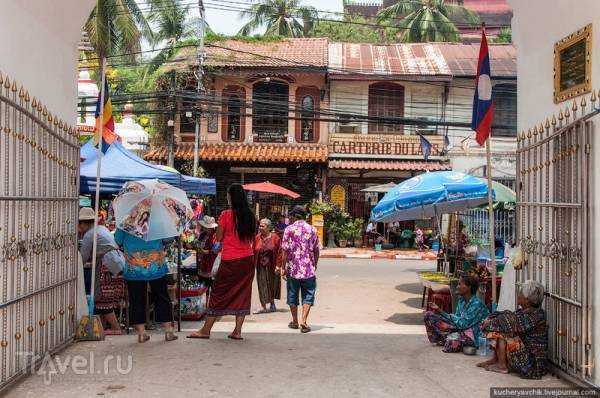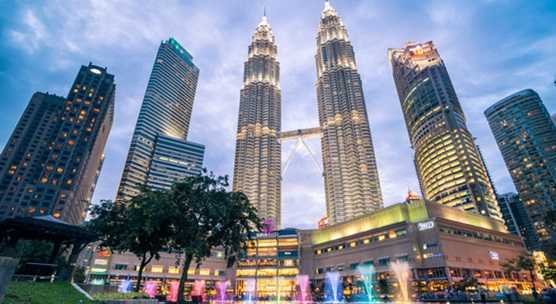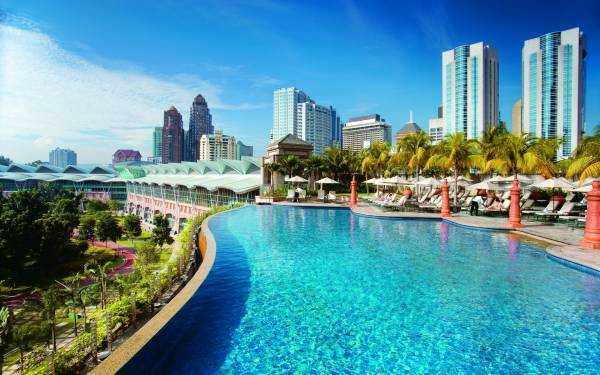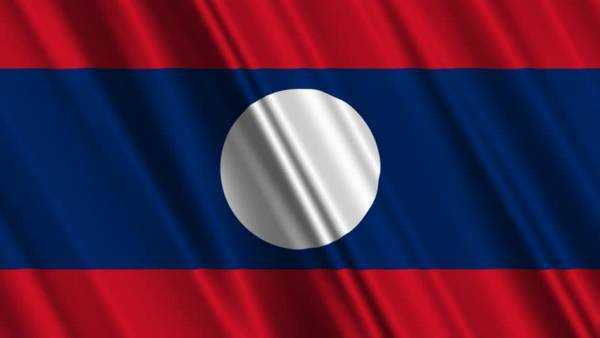Vientiane is an unusual capital. The festive spirit here is limited to just one central street. A four-lane highway with painted curbs and lanterns stretches from the presidential palace to the Arc de Triomphe, showing how well-kept and tidy Laos could be. Vientiane is divided into a fine main street with a couple of adjacent blocks, and the rest of the city. These two parts deserve a separate article—they are so different.

I flew from Luang Prabang to Vientiane on Lao Airlines. There were six of us in the 20-row ATR cabin: my friend, me, another European couple, and two Lao. A friendly flight attendant demonstrated the safety rules just like on any other plane in the world. The only local highlights on the flight were a magazine advertising a Mercedes in Lao and a narrow-eyed flight attendant. Flying on an Italian plane with international safety regulations is boring!

The flight was flying over a very picturesque region of Laos, but the ground was barely visible from the window. A damp, low fog blanketed the ground; the rainy season was approaching.

Only when approaching Vientiane, shortly before landing, could the outlines of houses be made out.

I was really looking forward to experiencing something exotic, and until the very last moment I was hoping that the domestic flight in Laos would be operated by some AN-24-type plane gifted by the USSR in exchange for bananas. I expected to be jolted on takeoff and tossed from side to side on landing, but the flight went without any discomfort. We weren't even fed during the flight—just like at home! The exotica greeted us as we descended the steps: an arrivals board with signs and a non-functioning conveyor belt, seemingly constructed from tank steel.

We left the airport building and set out to find a bus into town. We walked five hundred meters to an intersection with a major road. A traffic light controlled the traffic! You can count the number of controlled intersections in Laos on your fingers, and this light was one of ten.

We hopped on a passing city bus. The conductor helped us carry our backpacks. The passengers were smiling. In Laos, everyone smiles—I'll remember this pleasant attitude forever.

We tried to find out where the bus was going. The route sign was written in Lao script. Not a single person on board spoke English. I showed the conductor a map of Vientiane, but the Lao don't know how to read European maps. I later discovered that no one in Asia knows how to use European maps. I'll tell you what maps you need to take to Asia when I write a report on China. I tried to use my kitchen-sink French in conversation with the conductor: "centre," "ville," "de ville," and so on in that vein—she still didn't understand that we wanted to go to the city. She laughed, handed us tickets, and went off to talk to the driver.

The bus, against our will, wasn't heading to Vientiane, but to the suburbs. The route passed through the vast Vientiane metropolitan area. First, we drove along a paved avenue with guardrails, then turned onto a potholed road, then off the potholed road onto a dirt road, and finally, after about 40 minutes, we came to a temple in a palm grove somewhere far out in the countryside.

We passed villages where large families lived in one-story huts under a canopy of palm leaves, saw the cool mansions of wealthy Lao with their love of gilding and plaster columns on the facade, and one long, endless bazaar.

Along every road in Laos (this rule later proved applicable in Vietnam and China as well) stretches an endless row of stalls, always selling something. All of Asia is one endless bazaar stretching along the road.

On the way back, the bus passed the intersection where we'd boarded it and headed into downtown Vientiane. We trudged along completely featureless streets, only the buildings grew taller: first two, then three, and even four stories of concrete slabs. So imperceptibly, we entered the historic center. Through the bus window, I read the inscription "Presidential Palace" on a gold plaque on one of the fences. This building was marked on the European map of Vientiane in my guidebook, and from there, we could hail a tuk-tuk to the hostel. But one problem remained: we knew the specific address, but we couldn't explain it in Lao.

People in Laos live in abject poverty: high infant mortality, an African-scale lack of written language. 30% Lao can't read or write, including tuk-tuk drivers! Not a single driver could read the names of temples written in Lao letters in a guidebook. How else can you explain to a driver where you need to go when Lao, like other Asian languages, is stress-based? I've never been able to explain to a driver by ear where I wanted to go. The slightest deviation in stress means something else, and I sincerely hope I haven't inadvertently offended any of the drivers.

Illiteracy and a lack of basic English vocabulary don't stop some tuk-tuk drivers from preying on tourists. So, my friend and I were trying to hail a tuk-tuk to a hostel. We'd moved away from the main street, knowing from a well-read guidebook that it was home to the tuk-tuk mafia. Just as we rounded the corner onto a smaller street and waved at a passing tuk-tuk, a driver from the oncoming lane turned around and stopped right next to us. The hostel was on "Sikhom Road." I showed him my reservation printout from hostels.com. The driver couldn't read, let alone speak English. He asked me several times in Lao, and I kept repeating the charming "sihom road," "sihom road," "sihom road." The driver looked at me with utter bewilderment and threw up his hands. I realized I'd placed the stress incorrectly in that word and started trying different stresses as best I could. Like a burglar picking a master key, I changed the stress until the driver figured out which street he was talking about. "Sykhm lod!" the toothless tuk-tuk driver rejoiced, jumping off the engine and helping us climb into the back with our huge backpacks. We agreed on payment: five fingers, five thousand kip (60 cents). The taxi drivers on the main street wanted 20,000 kip from us; the guidebook said the standard rate within the city center ranged from 5,000 to 10,000 kip. Overjoyed, the tuk-tuk driver let a woman carrying bags off the back of the tuk-tuk. He said something to her, after which she calmly left the tuk-tuk.

We passed a couple of intersections, turned onto another street, drove for another five minutes, and then turned off the paved road into a dusty alley. Two houses down, we saw our hostel. The driver stopped, we got out, and gave him the promised five thousand kip. The toothless driver jumped up, waved his arms, and started shouting something in Lao. He widened his eyes, waved his five fingers, pointed at a five-thousand kip note, and shouted something. A guy came out of the hostel and came over to ask what had happened. It turned out the driver wanted not five, but fifty thousand kip! Six dollars! For a five-minute ride! It was an obvious scam. We stood on the street for another five minutes arguing, until the driver, through an interpreter, said, "At least give me ten thousand." Not knowing foreign languages doesn't stop some unscrupulous tuk-tuk drivers from ripping off tourists, although we haven't encountered such brazen cases of extortion since.

We checked into the hostel and set out to explore the city. We only had half a day to explore the Laotian capital: the next morning we planned to take a bus south to see the jungle and mountains. It was midday, a very hot midday, though the sun itself was invisible through the hazy sky.

Even from the bus window, I noticed how monotonous the streets of Vientiane were. Almost all the buildings in the city were faceless; they were "nothing special." The neighborhoods were indistinguishable, making it impossible to remember the way home. Later, the city put me in my place.

With its identical facades and crooked streets, Vientiane baffled me and became the first city in the world where I'd ever gotten lost. For over an hour, my friend and I—both excellent navigators with an impeccable sense of direction in any terrain—wandered the unlit streets of evening Vientiane, searching for a hostel I knew only by name and house number, but in Laos, no one can help you with that information. I walked through streets where the eye couldn't catch a single house to memorize its location. Every building seemed simultaneously familiar and unfamiliar—like a desert mirage.

After our tuk-tuk was doused with water at an intersection to celebrate the New Year, we were soaking wet. Our sneakers squelched as we walked. Darkness fell quickly, and mosquitoes swarmed in. Wet clothes attracted mosquitoes—we were eager to find our way home. The search for the legendary "Sihom Road" was endless—we wound our way through identical neighborhoods like Theseus in the Minotaur's labyrinth. No one was coming our way, and there was no one to ask for an address in Laos—people don't navigate by postal codes or names here. Rounding the next corner, we came upon an intersection with a traffic light, completely by chance. There are very few traffic lights in the Lao capital, and that controlled intersection immediately reminded me of the way home. Five minutes later, we were home.

The center of Vientiane looks neat and even clean. There's no trash strewn along the roads, separated by painted curbs. Apparently, it's cleaned frequently. To be fair, it should be noted that the center of Vientiane is mostly frequented by tourists, and even those are relatively few in the capital. Most backpackers either stay briefly in the city and then head straight to Vang Vieng, or fly directly to Luang Prabang to continue their journey through the jungles of northern Laos. Vientiane itself has far fewer tourists and tourism than Luang Prabang.

Laos is incredibly peaceful and safe, but Vientiane's main streets are lined with police boxes, and some key roads can be closed off with drawbridge aluminum fences, like in China.

Having begun the day before in Luang Prabang, New Year's celebrations continued in Vientiane. Dressed in colorful clothing, large groups of people (probably families and relatives) went to monasteries.





Source: travel.ru






